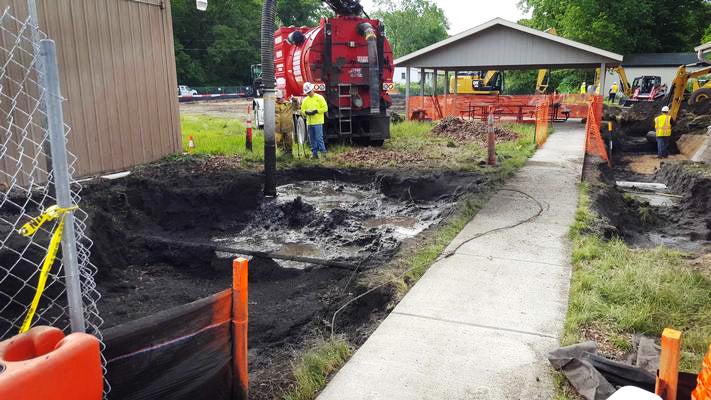EPA: Radiation from Coal Ash Poses Cancer Risk
More than 150 public interest groups urge the EPA to ban the widespread use of toxic coal ash as structural fill
Contact
The Environmental Protection Agency (EPA) recently published a draft risk assessment stating that the health risks of radioactivity of coal ash are much greater than previously estimated.
This prompted more than 150 public interest groups to send a letter today urging the EPA to ban the widespread use of toxic coal ash in place of soil for construction and landscaping projects in residential areas.
The letter describes the draft risk assessment: “Radioactivity is released from coal ash in subsurface deposits when ash is used as fill. EPA found cancer risks exceeding health standards when coal ash is mixed with soil at ratios that include very small amounts of coal ash (1-2% of the soil mixture). When coal ash constitutes 8% of the soil mixture, EPA found cancer risks above 1 in 10,000 — the threshold for EPA regulation. These findings are alarming because coal ash used as fill is often not diluted nor covered with soil to shield its radioactivity.”
People may be exposed to dangerous levels of radiation in coal ash that has been used as fill in neighborhoods, backyards, parks, and public areas, including playgrounds and school grounds. Exposure to excess levels of radiation causes cancer. Millions of tons of coal ash are used every year as a substitute for clean fill, and there are few restrictions and little to no oversight by EPA as to how it is used.
In Iredell County, North Carolina dozens of teenagers have been diagnosed with cancer in an area where coal ash was used extensively for fill and landscaping near homes; 40,000 tons of coal ash was used as fill near the local high school. (More details and examples below). A mother of a former high school student who developed thyroid cancer signed the letter along with over 100 other affected or concerned individuals.
Immense volumes of coal ash have historically been used as fill in the U.S. for more than a century. The American Coal Ash Association (ACCA) estimates that a total of 180 million tons of coal ash have been used in fill projects throughout the U.S. since 1980. If this coal ash was placed in box cars, the freight train would be long enough to circle the earth. Since most states do not regulate coal ash fill, safeguards are largely absent, and its use is likely underreported. Few states prohibit the placement of ash near drinking water wells, homes, or even playgrounds. To make matters worse, the use of coal ash as fill is rapidly increasing. This November, the ACAA reported that use of coal ash as structural fill rose by 40% from 2020 to 2021.
The EPA’s risk assessment also found arsenic in coal ash may present unacceptable health risks. In October EPA issued a draft toxicological assessment of arsenic that finds its cancer potency is 35 times higher than previously acknowledged.
Lisa Evans, an attorney with Earthjustice explained, “While the EPA has thankfully recently proposed safeguards to finally crack down on toxic coal ash left onsite at power plants, nothing prevents power plants from moving radioactive waste from their own backyards into the backyards and neighborhoods where American families live.”
Many people working at the site of the massive Kingston, TN coal ash spill developed health problems, including cancer, leukemia, and multiple myeloma after being exposed to coal ash without proper safety gear. December 22 marks the 15th anniversary of the spill, the largest toxic waste spill in U.S. history. One billion gallons of coal ash sludge destroyed 300 acres, dozens of homes, and polluted two rivers. Hundreds of cleanup workers were injured in the cleanup of the spill and more than 50 workers have since died.
Examples of where coal ash has been used as fill:
- Iredell County, North Carolina: The letter states, “Coal ash from Duke Energy’s Marshall Steam Station was routinely used as structural fill in landscaping and other projects in residential neighborhoods, including 40,000 tons of coal ash near the local high school. The rate of papillary thyroid cancer in Iredell County is 2-3 times higher than the state average, and cancer has stricken dozens of local teenagers.”
- Southeastern Puerto Rico: As described in the letter, “From 2004 to 2012, more than two million tons of coal ash from the AES Guayama Power Plant were used as fill in dozens of construction projects in southeastern Puerto Rico, including housing, hospital, and road projects. Most sites are located directly above the South Coast Aquifer in the vicinity of public supply water wells, and in some cases ash was placed directly in the aquifer. At dozens of sites, coal ash remains uncovered and close to homes, parks, and schools.” Testing of coal ash from the AES-PR Guayama plant in 2010 revealed levels of radiation that potentially exceeded the EPA’s protective limit.
- Town of Pines, Indiana: Coal ash was used throughout the town to fill low-lying areas and for the construction of roads, driveways, and parks. Coal ash contaminated the town’s drinking water wells, and the EPA declared the Town of Pines a Superfund site in 2001. Coal ash was used in the construction of a playground where arsenic was detected at levels more than seven times the health limit. It was later excavated.

Additional Resources
About Earthjustice
Earthjustice is the premier nonprofit environmental law organization. We wield the power of law and the strength of partnership to protect people's health, to preserve magnificent places and wildlife, to advance clean energy, and to combat climate change. We are here because the earth needs a good lawyer.